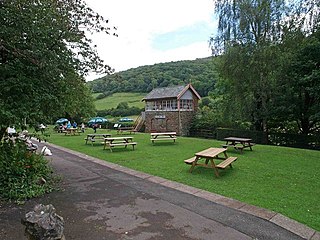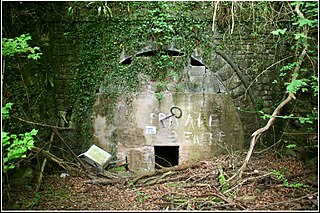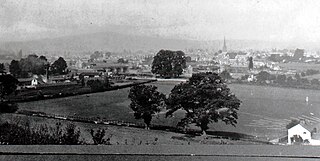
The Severn and Wye Railway began as an early tramroad network established in the Forest of Dean to facilitate the carriage of minerals to watercourses for onward conveyance. It was based on Lydney, where a small harbour was constructed, and opened its line to Parkend in 1810. It was progressively extended northwards, and a second line, the Mineral Loop was opened to connect newly opened mineral workings.

Coleford Great Western Railway Museum is a railway museum located in Coleford, Gloucestershire, England. The museum was founded in 1988. Based in the former GWR Goods Shed along the Coleford Railway. There was also another station situated at Coleford, it was opened by the Severn and Wye Railway. The Museum traces the history of all the railways in the Forest of Dean, Gloucestershire from the early 19th century when the first plateways were laid, to the 1970s when the Dean Forest Railway was founded. The Museum has information about the Wye Valley Railway, Severn & Wye Railway and Monmouth Troy railway station.

The Wye Valley Railway was a standard gauge railway that ran for nearly 15 miles (24 km) along the Lower Wye Valley between the towns of Chepstow and Monmouth, crossing several times between Wales and England. Opened on 1 November 1876, it was leased to, and worked by, the Great Western Railway (GWR), before being fully absorbed by the GWR in 1905.

Monmouth Troy was one of the two former railway stations at Monmouth. It was built in 1857 by the Coleford, Monmouth, Usk and Pontypool Railway and was used by several other branch lines as the local rail network expanded. The station closed in January 1964 following the closure of the last two lines to the station, the Wye Valley Railway and the Ross and Monmouth Railway.
The Coleford Railway was a railway company that constructed a short railway from near Monmouth to Coleford, close to the Forest of Dean. The company was sponsored by the Great Western Railway. It was built on part of the course of the Monmouth Railway, a horse-operated plateway, and it was intended that its primary business would be the conveyance of minerals and forest products from the Forest of Dean.

Tintern railway station served the village of Tintern on the Wye Valley Railway. It was opened in 1876 and closed for passengers in 1959 and freight in 1964, when the line was closed completely. It was the second largest station on the line, the most substantial being Monmouth Troy railway station.

The Coleford, Monmouth, Usk & Pontypool Railway (CMU&PR) was a standard gauge railway of 16 miles (26 km) which ran from Monmouth to Little Mill, near Pontypool in Monmouthshire, Wales. It was intended to convey the mineral products of the Forest of Dean to the ironworks of South Wales, by connecting to the Newport, Abergavenny and Hereford Railway at Little Mill Junction. The NAHR made the onward connection over its Taff Vale Extension line. The CMU&PR intended to acquire the Monmouth Railway, actually a horse-operated plateway, and convert it to locomotive operation.

The Ross and Monmouth Railway was a standard gauge railway of 13 miles (21 km) which ran between Ross-on-Wye, in Herefordshire, England and Monmouth, Wales.

The Tintern Wireworks Branch was a short branch line on the Wye Valley Railway. It was completed in 1874 and opened on 1 November 1876; the reason for the delay was that the Wye Valley Railway which the branch line fed into, was not completed until the latter date. It closed in 1935 when the rails buckled in the heat of the summer.
Redbrook on Wye railway station was a station serving the village of Redbrook on the now disused Wye Valley Railway. It was opened on 1 November 1876 with the rest of the line and remained open for 83 years, it closed in 1959. The sidings and passing loop remained open until late 1961 to serve the Tinplate Works in the village.

Symonds Yat railway station is a disused railway station on the Ross and Monmouth Railway constructed on the banks of the River Wye in Symonds Yat East.
Lydbrook Junction railway station is a disused railway station in England opened by the Ross and Monmouth Railway in 1873, it remained open for 91 years until 1964 when the line finally closed to freight, though passenger services ceased in 1959. The station was constructed in the hamlet of Stowfield approximately half a mile from Lydbrook and its viaduct on the Severn and Wye Railway. It was located approximately 4 miles and 34 chains along the railway from Ross-on-Wye station. In 1874 the Severn and Wye Railway opened a branch from Serridge Junction and Cinderford, passenger services commenced in 1875. All passenger trains along the S&W branch were withdrawn from 1929.
Monmouth Troy Goods Yard was a large goods yard near Monmouth Troy railway station in Monmouth, Wales. It was opened in 1857 by the Coleford, Monmouth, Usk and Pontypool Railway at the same time as the station. As other railways reached Monmouth Troy the goods yard grew in importance. At its height, the goods yard was used by the Wye Valley Railway, Coleford Railway, Ross and Monmouth Railway as well as the Coleford, Monmouth, Usk and Pontypool Railway. The goods yard closed in 1964 when the last two railways, the former Wye Valley Railway and Ross and Monmouth Railway, closed. The non-rail depot remained open until October 1964.
Usk (GWR) railway station is a disused railway station in the town of Usk, Monmouthshire, Wales. The station is now barely recognisable with the remains of the platforms beneath undergrowth, but the trackbed, the adjacent Usk Tunnel and road and river bridges remain extant and can be walked.
The Monmouth Railway, also known as the Monmouth Tramroad, was a horse-drawn plateway of 3 ft 6in gauge. It ran for about 5 miles (8.0 km) from Howler's Slade, east of Coleford, in Gloucestershire and Monmouth; there were two branches from other mineral sites. It was intended to bring mineral products of the Forest of Dean to Monmouth, and to the works alongside the River Wye.

The Monmouth Viaduct or Chippenham Meadow Viaduct is a 20-arch 183m red sandstone viaduct, with two 23m steel lattice-girder spans over the river. It carried the Coleford, Monmouth, Usk & Pontypool Railway line across the River Wye at Monmouth, Wales. A further river crossing by the Ross and Monmouth Railway was later built nearby.

Monmouth Gasworks was the facility for making town gas in Monmouth, Wales. The gasworks had its coal delivered by the Coleford, Monmouth, Usk and Pontypool Railway and was frequented by Charles Rolls to fill up his balloon.

Speech House Road railway station is a disused railway station opened by the former Severn and Wye Railway in 1875, it remained open for 88 years until the line, north of Parkend, closed to freight in 1963. Passenger trains on the Severn and Wye Railway, north of Lydney, were withdrawn from 1929.
Glascoed Halt was a request stop on the former Coleford, Monmouth, Usk and Pontypool Railway. It was opened in 1927 to serve the village of Glascoed, Monmouthshire. It was closed in 1955 following the withdrawal of passenger services on the line. It was located near a small overbridge bridge about 14 miles and 48 chains from Monmouth Troy. The halt consisted of a timber platform and GWR style pagoda.
Little Mill Junction was a station on the former Coleford, Monmouth, Usk and Pontypool Railway, located between the main Newport, Abergavenny and Hereford Railway line and the branch to Usk. It served the village of Little Mill, Monmouthshire.











